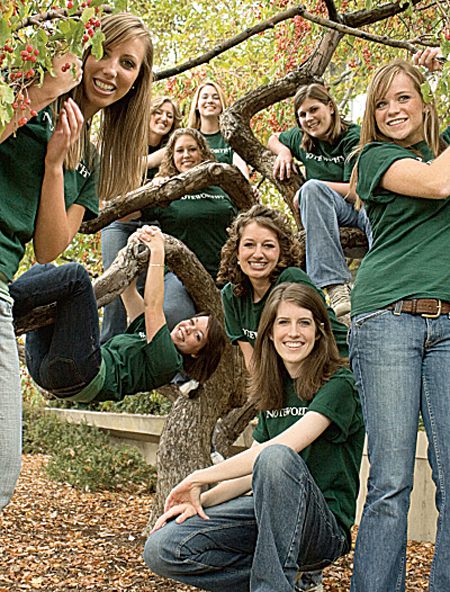By Richard H. Cracroft
When Johann Wolfgang von Goethe ended his monumental Faust with the line “Das Ewig-Weibliche zieht uns hinan” (The Eternal-Feminine draws us upward), he suggested the ineffable spiritual possibility inherent in woman to sense, welcome, and act on the highest within her and to inspire other human beings to comprehend their divine birthright and potential. Likewise, the stories of real Latter-day Saint women struggling to keep a firm grip on the iron rod while negotiating life’s slippery switchbacks are essentially noble, exemplary, “uplifting, and of good report.” Wallace Stegner, in The Gathering of Zion (1964), praises pioneer heroism and devotion, exclaiming, “Especially their women. Their women were incredible”(13).
In the past two decades, beginning withthe groundbreaking essays of Mormon Sisters (edited by Claudia Bushman; revised and reprinted, Utah State University Press, 1997), incredible LDS women scholars/writers (and men, too) have made the lives and works of Mormon women more accessible. Faithful scholar-saints have increasingly chosen to answer the taunts of well-intentioned but temporally bogged and misunderstanding feminists in the most suitable manner possible–by discovering, re-creating, and portraying the lives of LDS women who, turning a deaf ear to the world’s raucous demand to “do it my way,” find affirmation and fulfillment in “doing it His way,” as disciples of the Lord Jesus Christ. Recent works by BYU alumnaebring vividly to mind the accomplishment, example, and influence of the Latter-day Saint woman in drawing fellow mortals upward.
Marian Wilkinson Jensen, daughter of former BYUPresident Ernest L. and Sister Alice L. Wilkinson, has compiled Women of Commitment: Personal Portraits of Selected BYU Women (Bountiful: Horizon, 1997; 224 pp.; $17.98). Jensen has commissioned and collected 32 interesting–if eulogistic–biographies by the children, friends, or close associates of prominent 20th-century BYU women, from the wives of presidents and staff administrators to faculty women of the various colleges, from Rosalie R. Pratt, Kathryn B. Pardoe, and Anna B. Hart to Janet Calder, Janie Thompson, and Mae Blanch–right up to poet Susan Elizabeth Howe.
Celebrating one of Mormonism’s noblest women and finest painters, John W. Welch and Doris R. Dant have collected The Book of Mormon Paintings of Minerva Teichert (BYU Studies and Bookcraft, 1997; 168 pp.; $39.95). This lovely volume, which reproduces Teichert’s complete series of murals on events from the Book of Mormon, is enriched by historical, biographical, and artistic commentary, all of which underscore her steadfast purpose: to bear witness in art of the divine origins and content of the Book of Mormon. An exciting companion volume to Welch and Dant’s Teichert is Elaine Cannon’s Minerva! The Story of an Artist with a Mission (Bookcraft, 1997; 156 pp.; $19.95). Cannon, a former general president of the LDS Young Women organization and a wonderfully engaging writer, has run Minerva Teichert’s words and phrases, gleaned from the artist’s letters and journals, through the alembic of her own imagination to produce Teichert’s story in first-person narrative. For the first time, the real Minerva Teichert steps out from behind her paintings to reveal the real woman. And what a remarkable woman! “She was,” writes Cannon, “attractive, intelligent, strong willed, aware, generous, unselfish, and had a rich faith in God.” In fact, her faith in the divinity of the Book of Mormon and her conviction that she was impelled in her art by the Holy Ghost (which Elder Orson F.Whitney called “the genius of ‘Mormon Literature'”) charged her paintings with the spiritual power of a faithful LDS wife, mother, grandmother, and painter; hers is the success story of an “intelligent, trained, and highly motivated” woman who committed her life and soul and gifts to building the kingdom of God.
In the strong voices of heroic and devout men and women, Carol Cornwall Madsen, BYU professor of history and able discoverer of the prominent place of women in LDS history, recaptures how it was, day-by-day, on that legendary pioneer trek. In Journey to Zion: Voices From the Mormon Trail (Deseret Book, 1997; 750 pp.; $25.95), she weaves together dozens of accounts gleaned from journals, personal narratives, and painstaking research. She also enlivens our celebration of the pioneer sesquicentennial by allowing us to peer at events through the eyes and over the shoulders of the saints–via accounts penned mostly by women–as they sought, in profound faith, their refuge “far away in the West.” Journey to Zion is a major contribution to LDS history and demonstrates dramatically the spiritual motivation which at once enabled and drove the Saints to accomplish the nearly impossible.
The publication of Stone Spirits (BYU’s Charles Redd Center for Western Studies, 1997; $9.95) by Susan Elizabeth Howe, associate professor of English at BYU, is a welcome and refreshing landmark in western, LDS, and, well, human poetry. In some 39 poems divided into four sections, Howe uses western landscapes and motifs (stones, mountains, desert sands and flowers, elk horns, paintings) to probe, in telling imagery, as Professor Edward A. Geary writes in the foreword,”meditations on birth and death, on love and loss and suffering, on nature and art, nature and ethics, on the sense of menace and the necessity of risk-taking.” Throughout this important collection of poems, “there is always,” Geary concludes, “something western in the perspective: western light, western distance, western confidence. Each poem…represents in its own way a ‘hike to the spiries,'” and each poem, I might add, probes the human condition from a profound Latter-day Saint perspective.
Here is another first: LauraMaery Gold’s Mormons on the Internet: Online Resources for Latter-day Saints (Rocklin CA: Prima, 1997). It is a thorough and remarkably readable introduction to the Mormon Internet, with its invaluable collection of “Web sites, chat rooms, e-mail lists, discussion forums, and newsgroups operated and populated by people who love the Church and the gospel, and who want to share their joy with anyone willing to participate.” A warning: LDS online is addictive, time-consuming–and highly dangerous to Ignorance! Especially if your mission, like mine, has an active Web site!
Looking at life through spectacles at once feminine and Mormon enables a fresh and distinctive point of view. The Balm of Gilead: Women’s Stories of Finding Peace, introduced by Lynn Clark Callister (Deseret Book, 1997; 156 pp.; $15.95), is a selection of 30 fresh and often moving essays on seeking and finding spiritual peace, as gleaned from hundreds of rank-and-file submissions to the 1996 Women’s Conference at BYU. Another collection of 37 essays, arising from the same conference but by familiar LDS authors, including some General Authorities, is Clothed With Charity: Talks from the 1996 Women’s Conference (Deseret Book, 1997; 297 pp.; $15.95). Contributors to this volume, edited by Dawn Hall Anderson, Susette Fletcher Green, and Dlora Hall Dalton, discuss individual awakening to “the pure love of Christ” and its daily application. In a very different mode, Mollie Hobaugh-Sorensen presents The Forgotten Revolution: Rethinking the Sexual Revolution (Napa, CA: Sun West Publ., 1997), in which she calls on readers to engage in a last-ditch battle to return Virtue to its erstwhile prominence in shaping the human character.









